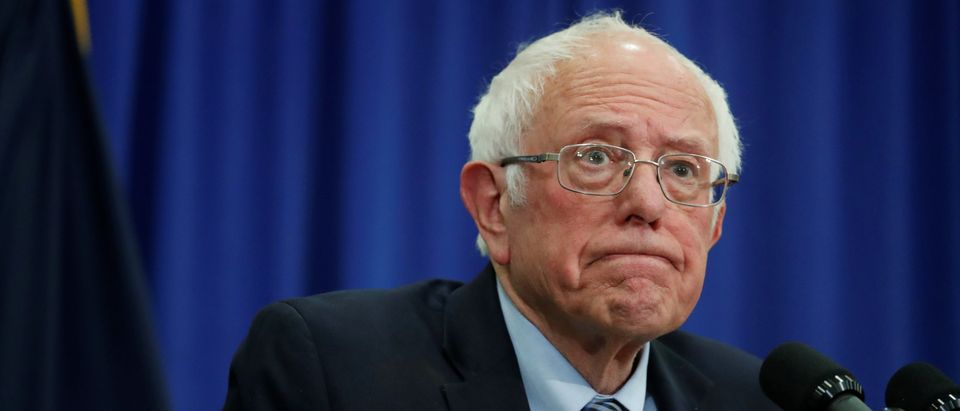Independent Vermont Sen. Bernie Sanders’ plan to win the 2020 Democratic nomination — and the presidency — was to rally the youth vote. So far, he has failed to deliver on that plan.
The focus on younger voters, who are notoriously unreliable on Election Day, was a shift from Sanders’ 2016 strategy that was rooted primarily in class-based issues. Sanders explained the move to the Los Angeles Times last December:
If you want a large voter turnout, if we understand that there are tens of millions of people in this country who don’t vote, who’ve kind of given up on the political process, that young people — although we’re seeing some real gains there and we’re working really hard on this thing — young people, who are by and large progressive — my guess is roughly speaking for every three people under 30 who vote, two of them are going to vote progressive, okay, but many of them don’t vote — I think I am by far the strongest candidate to reach out to those people.
Early polling appeared to reflect Sanders’ assertions that he was the proverbial Pied Piper who might finally bring young voters to the voting booths in the record numbers he had promised. (RELATED: ‘I Wouldn’t Put Anything Past Bernie And His Supporters’: Meghan McCain Says Bernie Will Not Go Quietly)
Bernie Sanders has tied or led every public poll taken this month in Texas, the second-largest #SuperTuesday delegate prize.
Progressive groups argue he’s uniquely capable of motivating the state’s large population of young and non-white voters.https://t.co/H2rFOBXwcz pic.twitter.com/jKffUdXRo8
— POLITICO (@politico) March 3, 2020
Bernie Sanders is three times more popular than Joe Biden among young black voters, poll shows https://t.co/lb5IXwsrX8
— Newsweek (@Newsweek) February 28, 2020
And Sanders has had no trouble filling parks and auditoriums with supporters — many of whom appear to fall in that younger age bracket.
Quite a few people here at the Bernie Sanders rally in Grant Park. #Chicago #twill pic.twitter.com/yQ4aofbAIf
— Tyler LaRiviere (@TylerLaRiviere) March 7, 2020
But as the primaries and caucuses began in earnest and American voters headed to their polling places to cast their votes, Sanders’ promised coalition appeared to fall apart. Sanders did well enough in Iowa and New Hampshire to hold on to his status as the presumptive “one to beat,” but even then the cracks in the foundation were beginning to show.
According to CNN exit-polling data compiled by the Brookings Institute, Sanders “has not changed the Democratic electorate in a significant way, and in fact, has seen key setbacks in the precise groups he has said he would deliver on.”
Comparing data from the 2016 primary and the 2020 primary in the first 12 states that voted, only one state — Iowa — saw an increase in younger voters. In 2016, for example, voters aged 17-29 made up 18% of Democratic voters overall. In 2020, that number grew to 24%.
But Iowa appeared to be a fluke, as all 11 of the other states compared — including Sanders’ home state of Vermont — showed a drop off in younger voters. And with few exceptions, Democrats in those states voted overwhelmingly for former Vice President Joe Biden.
- New Hampshire dropped from 19% (2016) to 13% (2020)
- Nevada dropped from 18% (2016) to 17% (2020)
- South Carolina dropped from 15% (2016) to 11% (2020)
- Alabama dropped from 14% (2016) to 10% (2020)
- Massachusetts dropped from 19% (2016) to 16% (2020)
- North Carolina dropped from 18% (2016) to 14% (2020)
- Oklahoma dropped from 12% (2016) to 10% (2020)
- Tennessee dropped from 15% (2016) to 11% (2020)
- Texas dropped from 20% (2016) to 15% (2020)
- Vermont dropped from 15% (2016) to 11% (2020)
- Virginia dropped from 16% (2016) to 13% (2020)
And that pattern appeared to hold in the second “mini” Super Tuesday as well:
- Missouri dropped from 16% (2016) to 14% (2020)
- Michigan dropped from 19% (2016) to 16% (2020)
- Mississippi dropped from 15% (2016) to 13% (2020)
All three of those states also voted for Biden.
Bernie Sanders’s promise to build a new coalition has not come to fruition, and that failure has knocked him out of frontrunner status in the Democratic nomination contest, writes @JohnJHudak. https://t.co/CvHB6a1dIb
— Brookings (@BrookingsInst) March 11, 2020
The key to the Bernie Revolution is getting a woefully unreliable group of voters to the poll…the young.
The truth is they didn’t show up yesterday (well, they did in Utah. Shout-out to Bernie Utah team)!
Will they show up for the next primaries? #utpol https://t.co/7k2mcXwrhQ— Jim Dabakis (@JimDabakis) March 4, 2020
Only 44% of adults 18-29 knew Bernie Sanders won Nevada, according to new @MorningConsult poll.
Young voters may be engaged like never before, but the bar has been very low…and they still don’t vote at rates anywhere near their 65+ Boomer counterparts.https://t.co/U1oMyQ0thm
— Noah Pransky (@noahpransky) February 24, 2020
Sanders gave a press conference Wednesday announcing his plan to stay in the race and claiming ideological victory in the face of electoral shortfall.
Sen. Sanders: “While our campaign has won the ideological debate, we are losing the debate over electability.”https://t.co/Qw4n414huS
— MSNBC (@MSNBC) March 11, 2020
Sanders surrogate and New York Democratic Rep. Alexandria Ocasio-Cortez made the same claim to Fox News’ Bret Baier, who asked how progressives could claim ideological victory when Sanders was losing to Biden.
Ocasio-Cortez appeared to claim that the main reason for that was “rampant voter suppression.”
AOC is asked by @BretBaier “how can you say the progressive position is prevailing nationwide when Joe Biden is winning so much?”
She attributes the losses to voter suppression. pic.twitter.com/1YK5oo2SKO
— Daily Caller (@DailyCaller) March 12, 2020
But Sanders does not appear to be a fluke: a number of Ocasio-Cortez-backed progressive Democrats have failed to disrupt the status quo, losing in their respective primaries to more moderate candidates.



